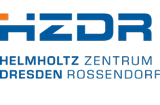News of October 8th, 2018
Materials research can be so beautiful
Two of the winning contributions to the cfaed competition for the most beautiful science picture originated at the Helmholtz Zentrum Dresden-Rossendorf.
Winning picture: Field effect transistor, based on semiconducting 2-D-Polymers (colored streaks). Microskope image, the intricate gold electrodes are just 20 micrometers wide. The figure "5" is about 0,4 millimeters high.
Source: Himani Arora (HZDR)
And the winner is: Himani Arora. Her microscope photograph shows electronic structures from organic semiconducting polymers and delicate gold electrodes. With this picture, the PhD student at the Institute of Ion Beam Physics and Materials Research came first in the competition for the most beautiful science picture in the field of materials research and nanotechnology in Dresden. The competition is sponsored every year by the 'center for advancing electronics' (cfaed) at the Technische Universität Dresden (TU Dresden).
"Choosing the winner was very difficult in 2018," says Christiane Kunath, who, together with her colleagues at the cfaed, has been organizing the competition for scientists in the field of nanomaterials since 2016. "There were so many beautiful and expressive images. Himani Arora alone submitted more than 20 photographs. Her winning picture finally won the most jury votes." The graphic designer herself belongs to the jury, which is made up of four internal members. "We want the competition to show that cutting-edge research can be aesthetically very pleasing, especially in the materials sciences." The prizes are worth 500, 300 and 100 euros. This year, the cfaed awarded two third places for the first time – the two entries had received exactly the same number of points from the jury.
Third place: Artistic representation of semiconductor nanowires on silicon, generated in a vacuum with molecular beams. The dark areas are microscope images of nanometers with lower magnification.
Source: Leila Balaghi / René Hübner (HZDR)
One third prize was also awarded to the HZDR. The PhD student Leila Balaghi received the award for her artistic representation of special semiconductor nanowires. Researchers generate such structures in a vacuum on a silicon layer using molecular beams. The properties of the semiconductor depend on their exact chemical composition. "In her graphic, Leila Balaghi depicts the elements gallium, indium and aluminum in different colors," says juror Christiane Kunath. "The two darkfield pictures of finely dispersed nanowires under the optical microscope give the image a particular accent." Leila Balaghi, with a degree in electrical engineering from University of Tabriz/Iran, has been pursuing her PhD in the spectroscopy department of HZDR. Her research focuses on the electronic and optoelectronic properties of special semiconductor nanowires, which are grown on silicon substrates by molecular beam epitaxy.
Success as a team
Prof. Manfred Helm, Director at the Institute of Ion Beam Physics and Materials Research, is delighted with the prizes of the two PhD students. "They both have great talent; I expressly encouraged them to take part." Ultimately, there is a whole team behind every competition entry. Himani Arora is researching on novel two-dimensional semiconductor channels for her doctorate in Dr. Artur Erbe's group at the International Helmholtz Research School (IHRS) NanoNet. She is a specialist in creating the tiny gold contacts that are necessary for electronic and optoelectronic investigations. The most important 'tool' for this is electron beam lithography. Organic metal-containing polymers with semiconducting properties are provided by a team led by Prof. Xinliang Feng in the Department of Chemistry and Food Chemistry at the TU Dresden. As an expert in molecular functional materials, he is one of the research partners in the NanoNet network, which is coordinated by the HZDR.
Leila Balaghi is being supervised in her doctoral studies by Dr. Emmanouil Dimakis in HZDR's spectroscopy department. Her PhD experiences are on the design and characterization of semiconductor nanowires for high electron mobility applications by strain engineering. At the same time, she is researching under Prof. Thomas Mikolajick at NaMLab gGmbH, a research company of TU Dresden and a cfaed partner. Her award-winning graphic in the cfaed competition is based on X-ray spectroscopic images using Dr. René Hübner's transmission electron microscope at the HZDR's Ion Beam Center. The image illustrates an artistic arrangement of nanowire cross-sections, where the different colors correspond to different group-III elements. The two panels represent dark field optical micrographs of nanowires placed flat on a substrate.
Himani Arora is a PhD Student at the International Helmholtz Research School (IHRS) NanoNet; she is engaged in Arthur Erbe's group.
Source: private
Leila Balaghi studied electrical engineering at the University of Tabriz (Iran). Since 2015 she has been engaged in research at the HZDR Institute of Ion Beam Physics and Materials Research.
Source: private
For more information:
Prof. Manfred Helm | Director
Institute of Ion Beam Physics and Materials Research at the HZDR
Phone: +49 351 260-2260 | Email m.helm@hzdr.de
Helmholtz-Zentrum Dresden-Rossendorf | Bautzner Landstraße 400 | D-01328 Dresden
Christiane Kunath | Designer
cfaed center for advancing electronics, Dresden at the TU Dresden
Phone: +49 351 463 42849 | Email: christiane.kunath@tu-dresden.de
Technische Universität Dresden | D-01062 Dresden


